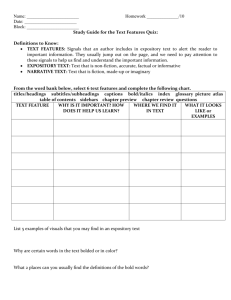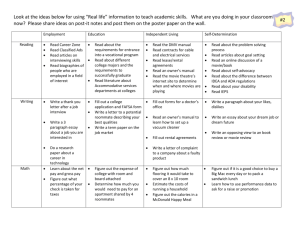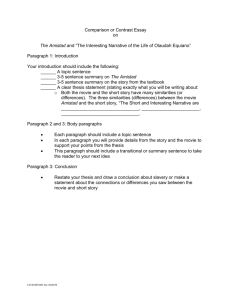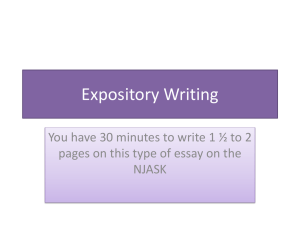Informational/Explanatory Writing PowerPoint
advertisement
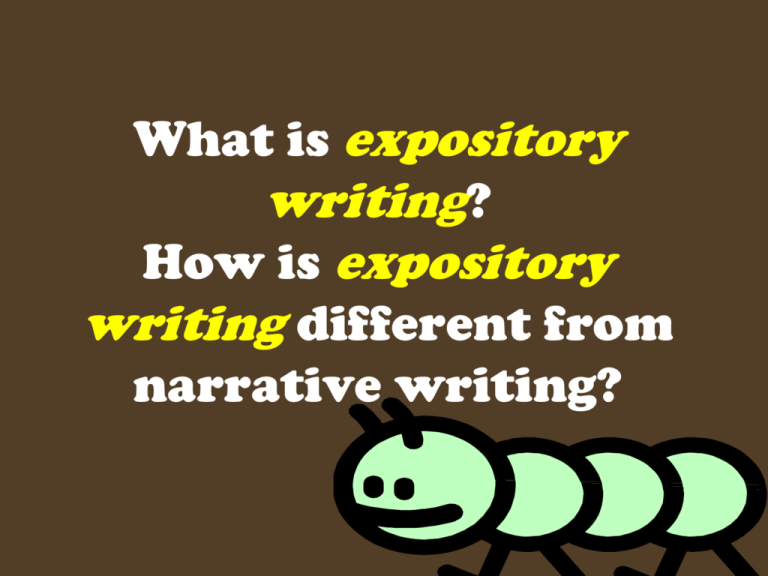
What is expository writing? How is expository writing different from narrative writing? Standard and EQ: ELAGSE6W2: Write informative/explanatory texts to examine a topic and convey ideas, concepts, and information through the selection, organization, and analysis of relevant content. EQ: How can I write an effective informative/explanatory text that clearly conveys ideas, concepts, and information? By the end of this lesson, students will know about: • informative text structures (e.g., problem/solution, cause/effect, sequential) • explanatory text structures (e.g., description or definition with causes, motives, or reasons) • relevant content that supports or explains a topic By the end of this lesson, students will be able to: • determine the organizational structure that is most appropriate for the topic and purpose • organize ideas, new information, and prior knowledge to clearly explain the topic • analyze relevant content What is expository writing? It … 1. gives facts. 2. explains. 3. gives steps in a process. 4. presents ideas in a logical order or sequence. What key words show it’s an expository prompt? 1. Most people like some type of music. Think about your favorite type of music and explain why you like that particular type of music. 2. Tell how to make a grilled cheese sandwich. 3. Explain how two characters in a story are similar and different. Explain and tell how are key words. Narrative vs. Expository o • Tells a story o • Has action o • Author’s purpose: to entertain o • Has conflict & dialogue • Has characters & theme o • Has a definite beginning, middle, and end • Key words- Tell about a time, tell what happened next, and write a story • Ex. Folktale, fable, myths, suspense-filled stories Provides information Explanations/ directions Author’s purpose: to inform or explain Has a central idea (thesis) Organized by: compare/contrast, cause & effect, chronological order, problem & solution, or question/answer o Key words- Explain, tell how o Ex. Internet, biography, dictionary, encyclopedia Which type of prompt is each? • Create a story set in the future with aliens as characters. _______________ • There are many positive and challenging things about the sixth grade. Explain what these things are. ________________ Narrative or Expository? 1. Narrative 2. Expository How did you know? Graphic Organizer HOOK Supporting ideas conclusion details Introductions (Opening paragraph) Grab the reader’s attention by: –Asking a question ???? –Onomatopoeia (Bang!) –Using some key words from the writing prompt. Expository Writing uses: • a plan of what you are going to be talking about in the paragraphs. • Each supporting detail starts a new paragraph. Essay needs: •Introduction paragraph (HOOK & THESIS) •Body paragraphs (SUPPORTING IDEAS & DETAILS) •Concluding paragraph (RESTATE SUPPORTING IDEAS)= 4-5 PARAGRAPHS REMEMBER= 3-4 different TRANSITION WORDS NOW: Let’s practice 1.When you think of wars, which one was the worst? 2.Many people would describe the American Civil War as the most bitter war in US history. 3.The Civil War was the result of many factors. 4. One cause was the different economies of the North and South. 5. Another reason for the war was the dispute over states’ rights.6. Finally, one of the most wellknown causes was the battle over slavery. Write on the graphic organizer: the hook, the thesis statement, and supporting ideas. Thesis Statement----Sentence 3.The Civil War was the result of many factors. Supporting ideas HOOK- SENT 1- Uses A QUESTION Sent 4. Sent 5 Sent 6 How do I write a comparison and contrast essay? Let’s think about it in relation to comparing and contrasting a book and a movie… Compare and Contrast Essay Organize your essay using one of the following methods: • Point by Point Method • Block Method or Whole-to-Whole • Similarities and Differences Let’s think about it in relation to comparing and contrasting a book and a movie… Point by Point Method In this structure, you explain one point of comparison before moving to the next point. For instance, you would write about the characters in the book and movie in one section; then you would write about the setting in the book and movie in the next section. Point by Point Method Introduction Point #1 (Characters in book and movie) Point #2 (Setting in book and movie) Conclusion Block Method or Whole-to Whole In this structure, you say everything about one item then everything about the other. For instance, say everything about the characters, setting, and plot for the book then everything about the characters, setting, and plot for the movie. Whole-toWhole comparison and contrast uses a separate section or paragraph for each item you're discussing. Block Method or Whole-to Whole Introduction Book (Characters, Setting) Movie (Characters, Setting) Conclusion Similarities-to-Differences Strategy In this structure, you explain all the similarities about the items being compared and then you explain all the differences. For instance, you might explain that the characters and plot were similar in both the book and movie in the one section. In the next section, you could explain that the settings were different. The book took place during the summer while the movie took place during the winter. Similarities-to-Differences Strategy Introduction Similarities Differences Conclusion Transitional Words and Phrases to Compare/Contrast Compare Contrast • • • • • • • • • • • • • • • also and another in the same way likewise moreover similarly too although but even though however on the other hand unlike yet


